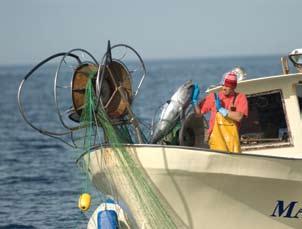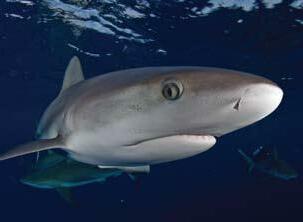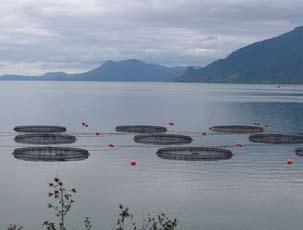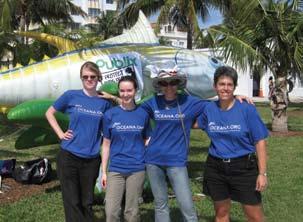
9 minute read
Victories
Oceana works on a limited number of campaigns that focus on the oceans’ immediate conservation needs.
© OCEANA | Carlos Suárez
RESPONSIBLE FISHING
Scientists estimate that seafood species could go extinct by the middle of this century if high-pressure, wasteful fishing practices continue at the current rate. Ninety percent of the big fish – sharks, tuna, swordfish – are already gone. Destructive fishing practices like bottom trawling waste more than 16 billion pounds of fish and kill countless marine mammals every year, while obliterating ocean habitat like coral reefs and seamounts that can take decades or centuries to recover.
Oceana works to ensure that fish are taken out of the ocean only at sustainable rates based on science, and to protect habitats by drastically reducing bycatch and its effects on the marine ecosystem.
VICTORY: CHINOOk SALMON pROTECTEd FROM pOLLOCk NETS
Oceana joined with a coalition of western Alaska communities and salmon fishermen to limit on the number of Chinook salmon that the largest groundfish fishery in the world can kill as bycatch. As a result, in June, the North Pacific Fishery Management Council took the first serious step towards establishing a hard cap on Chinook salmon bycatch in the Bering Sea pollock fishery. The need for a bycatch cap on salmon was imperative, as in 2007, the pollock fishery – the second largest in the world – incidentally caught more than 120,000 salmon in a year when Chinook populations collapsed along the U.S. West Coast.
The council moved toward setting a cap of catching 68,392 salmon. Upon reaching the cap, the pollock fishery will have to close for the season. Pollock trawlers in the Bering Sea catch more than two billion pounds of pollock each year. Trawling is an indiscriminate fishing method that often results in bycatch, including dolphins, whales, sharks, seabirds and other untargeted species.
VICTORY: 115 MILLION ACRES OF BERINg SEA pROTECTEd FROM TRAWLINg
In August, the National Marine Fisheries Service enacted new protections that closed nearly 115 million acres of the Bering Sea from destructive bottom trawling. The closure adopted Oceana’s approach of freezing the current “footprint” already trawled and prevents future expansion of this damaging fishing technique. Combined with closures that adopted the Oceana approach in the Aleutian Islands and other parts of Alaska and in state and federal waters off Washington, Oregon and California in 2006, this newest rule brings the total area of U.S. Pacific waters protected from bottom trawling to more than 531 million acres, an area five times the size of California. Worldwide, Oceana has protected more than 640 million acres of seafloor from bottom trawling.
The regulations establish a northern boundary for trawling in the Bering Sea and protect one of the world’s most productive and diverse ocean ecosystems. The Bering Sea is home to 26 species of marine mammals, including the critically endangered northern right whale, millions of seabirds from seven continents and more than 450 species of fish.
Local communities and other conservation groups supported the Oceana approach to protecting this area from trawling, which involves dragging weighted nets along the seafloor, killing sealife and destroying corals, seamounts and other important habitat.
VICTORY: WHALES pROTECTEd IN CHILE
Chile’s President Batchelet announced in June that she had established a permanent sanctuary for whales from lethal exploitation in all of Chile’s waters. Oceana worked in coalition with several environmental groups to ensure the President’s declaration. Although this was an important announcement, Oceana also clearly delivered the message that additional efforts are necessary to protect the critical habitats to make this declaration effective.
VICTORY: FRENCH dRIFTNETS OFF THE WATER
After Oceana’s Ranger spent three summers documenting the use of illegal driftnets on French fishing ships, the European Court of Justice finally eliminated a loophole that allowed the French to continue using these nets. The European Union banned the use of driftnets in 2002, but the ships continued to operate with support from the government of France. Thanks to the ruling, French illegal driftnets were off the water in 2008.
By refusing to grant an exception to the French driftnet fleet, the court upheld the 2002 ban and effectively took 92 driftnetters off the water, potentially saving about 25,000 juvenile bluefin tuna each year.
In 2007, a group of these driftnetters surrounded and threatened Ranger, which had been photographing and filming the nets at work. The ensuing media attention helped highlight this wasteful and illegal fishing practice and pushed policymakers toward ending the use of these nets.
Made of multifilament diagonal mesh, driftnets hang vertically in the water between polystyrene floaters and weighted bottoms and can reach up to five miles in length in a set. Between the months of May and October, fishermen leave the nets for up to six hours overnight on calm seas before hauling them in. The nets are notorious for catching thousands of creatures besides bluefin tuna, including ocean sunfish, pelagic stingrays, loggerhead sea turtles, striped dolphins, sperm whales and pilot whales. sharks are killed annually, largely for their fins, but also for their meat and as incidental bycatch, and often without respect to species, size or age. Without sharks, the oceans’ top predators, marine ecosystems cannot thrive. Oceana continues to push to protect these graceful predators.

SAFEGUARDING SHARKS
In its global shark campaign, Oceana has made significant progress across the planet. Since the middle of the 20th century, shark populations have plummeted under the strain of intense commercial fishing. More than 100 million
© OCEANA | Carlos Suárez
VICTORY: dEEp SEA SHARkS pROTECTEd IN EuROpE
In December 2006, European Union Fisheries Commissioner Joe Borg committed to reducing the number of deep-sea sharks killed by the fishing industry every year. Deep-sea sharks are among the most vulnerable species to overfishing because they reproduce slowly and produce small litters of baby sharks, or pups.
Two years after Borg’s commitment, and after continued pressure from Oceana, the European Union agreed to reduce the total allowable catch for deep-sea shark species, including the leafscale gulper shark and Portuguese dogfish. The E.U. also set a goal of reducing the catch by 50 percent in 2009 and 100 percent in 2010, giving these sharks an opportunity to recover to healthy population levels.
VICTORY: SHARk IdENTIFICATION CARd AdOpTEd IN CHILE
In July, Chile’s Undersecretary for Fisheries adopted Oceana’s shark identification card as an official method for Chilean fisheries to estimate shark populations and bycatch rates. This is a crucial step in counting, capping and controlling shark bycatch. Previously, little was known about how many and what species of sharks were killed by the fishing industry every year. Under its new Shark National Plan of Action, Chile must reduce shark bycatch and improve knowledge of shark populations.
The card was printed by the Chilean government and distributed among fishermen and scientific observers.
VICTORY: ATLANTIC, guLF OF MExICO SHARkS pROTECTEd FROM FINNINg
In precedent-setting decisions by fisheries agencies, sharks caught in federal fisheries in the U.S. Atlantic Ocean and Gulf of Mexico and state fisheries in the Atlantic were required to be landed whole with their fins still naturally attached in 2008.
Previous regulations required only that shark fins and carcasses be brought to dock in a specific ratio, allowing high grading, or the mixing and matching of the highest value fins and carcass, to occur and making the identification of species difficult. The new regulations requiring the landing sharks with their fins still attached allow for improved enforcement and data collection.
Sharks are in peril around the world from overfishing, driven in large part by the lucrative trade in shark fins. The new fins-attached regulations, by the U.S. National Marine Fisheries Service and the Atlantic States Marine Fisheries Commission, raise the bar for shark conservation measures globally.
© OCEANA | Eduardo Sorensen

CURBING ANTIBIOTIC USE IN AQUACULTURE
In 2008, Chile’s salmon industry was rocked by disease. An outbreak of infectious salmon anemia dealt a severe blow to the rapidly expanding industry. This highly contagious virus is deadly to fish. News of the outbreak worried consumers worldwide, and the major U.S. grocery chain Safeway ended purchases of salmon from Marine Harvest, the largest aquaculture company in Chile.
The quick spread of the outbreak stemmed from the crowded pens typical of Chilean aquaculture, with about 55 pounds of fish per cubic meter. Rather than keeping less fish per pen, the industry used excessive amounts of antibiotics in an attempt to stave off disease. According to a top scientist, Chile used about 300 times the amount of antibiotics of Norway, the only country that produces more farmed salmon than Chile. Some of the antibiotics are not approved by the World Health Organization for use in livestock.
VICTORY: CHILE RECOMMENdS ENdINg ExCESSIVE ANTIBIOTIC uSE IN SALMON FARMS
After campaigning by Oceana, the Chilean government body known as the Salmon Task Force recommended ending the excessive use of antibiotics in salmon farms in December. This will curb the overuse of antibiotics created for human health, end the overpopulation of salmon pens and lessen the amount of fish feces released into the marine environment. In addition, it will slow down the expansion of the industry into the pristine fjords of Patagonia. five of the nine mercury-polluting factories to eliminate mercury use.

Seafood contamination is a significant problem for the nearly one billion people around the world who depend on seafood as a primary source of protein. The presence of mercury is especially dangerous for small children and women of childbearing age. The U.S. Food and Drug Administration (FDA) has advised these groups to eat no more than six ounces of albacore tuna or tuna steaks per week because of mercury and to completely avoid eating swordfish, shark, tilefish and mackerel.
Oceana’s campaign to prevent seafood contamination is twofold: to end needless mercury pollution from outdated chlorine plants, and to convince major grocery stores in the United States to post the FDA advisory on mercury in seafood.
© OCEANA
PREVENTING SEAFOOD CONTAMINATION
When Oceana began its campaign to end seafood contamination in 2005, nine chlorine factories in the United States used outdated technology that resulted in mercury pollution entering the atmosphere and waterways, eventually finding its way into popular seafood species like tuna and swordfish. Since 2005, Oceana has convinced
VICTORY: gROCERY STORES AddEd TO gREEN LIST
In January, after Oceana published a report on the levels of mercury in grocery store-bought seafood, Kroger and Harris Teeter grocery companies announced their intent to post the FDA advisory at the point of sale. In August, Costco agreed to post the advisory as well and earned a spot on Oceana’s Green List of grocers. These companies’ stores are now among the more than 36 percent of major grocers in the U.S. – or more than 6,400 individual stores – that post the U.S. Food and Drug Administration advice on signs at seafood counters.
The Green List now includes many of the most prominent grocery store chains in the U.S., including Albertsons, Whole Foods, Trader Joe’s and Safeway and all its subsidiaries. See the entire Green List at www.oceana.org/greenlist.








